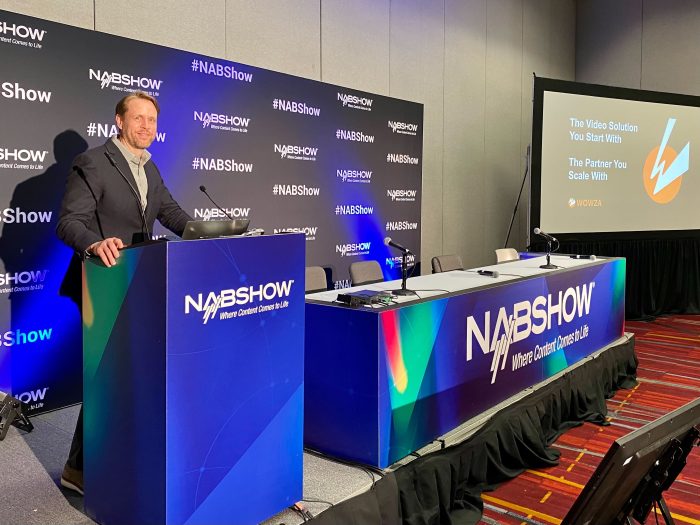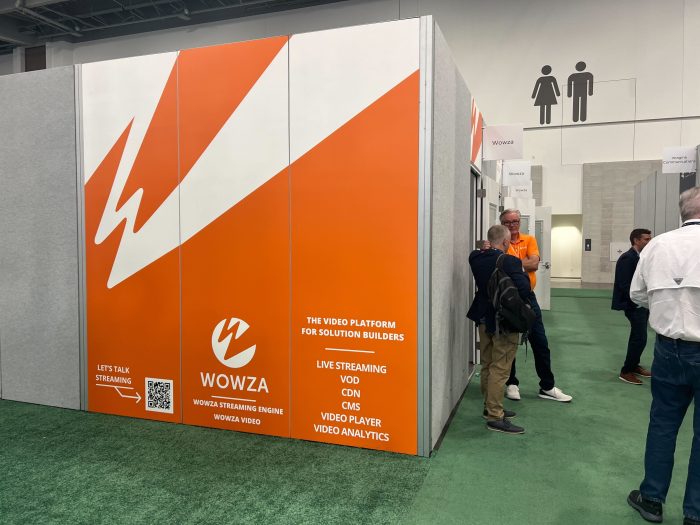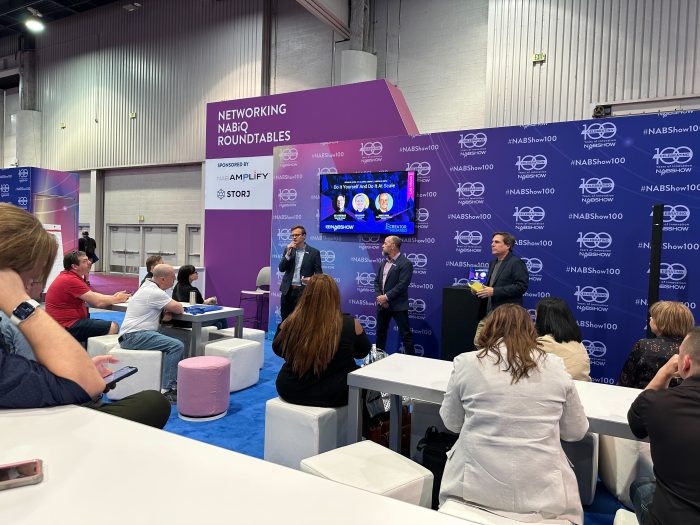Key Takeaways From NAB 2023

The 2023 NAB show was the second after the event was forced to take a two-year hiatus during COVID. While we still weren’t up to 2019 numbers, attendees counted in at 65,000+, around 12,500 more than last year. As NAB CEO and President Curtis LeGeyt said, this event was celebrating over 100 years of innovation, so it was exciting to have that many exhibitors, partners, and attendees from around the world join in.
The Wowza team had a packed schedule, but I made sure to keep a pulse on the overall conference to keep up with the most popular trends and topics people were dedicating their time and attention to. My observations are as follows:
Focus on the Workflow
When most people hear the word “streaming,” they think of media and entertainment. However, streaming technology’s biggest growth over the next year will be outside of these sectors, instead in areas more like enterprise communications, the creator economy, amateur sports, and healthcare.
The key to success for these verticals is simplifying the streaming workflow and making production easier. Many of these use cases can rely less on traditional on-prem production workflows to create and distribute content to viewers, instead opting for more innovative cloud-based solutions. Improvement in interoperability between vendors and products still represents a challenge here, but I predict this won’t take long when companies realize the benefits associated with cloud production.
What are such benefits? Cloud-based production tools, such as switching, editing, graphics, and compositing, show a great deal of promise inside and outside the broadcast space, even going so far as to rival on-premises solutions. For example, in the case of switching, services and tools are becoming more widely available to convert NDI, SDI, and ST21110 feeds into IP formats like SRT. This process allows for near real-time cloud-based switching, mixing and even compositing while maintaining the highest quality possible. The ability to create dynamic graphic overlays with only a browser and add them seamlessly to a stream is easier than ever before, allowing anyone to elevate their streams to production quality.
Warner Bros. Discovery is a major industry player actively and aggressively pursuing live cloud-based production, particularly in the sports sector. This process is cheaper because it requires relocating and operating much less equipment, so the company is already testing software-based production control rooms (PCRs) in New York, D.C., Atlanta, and the U.K. However, cloud egress costs are still substantial and are a major barrier to cloud adoption, so I predict a rise in hybrid solutions that will help companies reap the affordability of remote production while simultaneously simplifying the workflows involved with the best of on-premises resources.

What Does AI Really Mean for Video?
AI is a hot topic nowadays. What does can it do? What will it be able to do soon? Truthfully, I found last year’s buzz around the metaverse to be mostly hype with little substance, but AI feels different, and I think this is only the beginning of exploring what AI can do for and to the streaming landscape. There were many AI applications on display at NAB 2023, so here’s a list of the ones I found most notable:
- In the sports world, broadcasters are increasingly leveraging AI for ball tracking, identifying key game moments for replay, automatically creating highlights, and more.
- MediaKind and Bitmovin have introduced AI-based video encoding and scaling solutions that promise to greatly increase encoding efficiency while minimizing bandwidth
- Newsbridge created MXT-1, an indexing technology that uses natural-language models and multimodal AI to generate human-like descriptions of video content, photos, and audio files.
- Discussions at the Devoncroft summit centered around AI-based functionality like metadata extraction, synopsis creation, scene marking, and context analysis (including elements like sentiment and emotion). Manual and visual searches are time consuming, but AI and ML can make it easy to find a specific clip within a longer video with a few keywords.
- Qvest’s NAB presentation emphasized automated workflows with generative AI for media applications, including the integration of ChatGPT4. Qvest mentioned the Fortuna Dusseldorf workflow — a German football club — that combines audio commentary with speech-to-text analysis to allow ChatGPT to provide summary information for creating video highlights.
Ultimately, it seems one of the most promising ways AI can aid production is through content sourcing, searching, and curation. Philippe Petitpont, CEO and co-founder of Newsbridge, says, “AI can source content automatically, based on a search. A reporter can say, ‘I want a baseball stadium at night in California,’ and automatically AI can search footage and show in the search engine, relevant content that will be useful. In a second, the reporter can have all the images, and that can be done over a thousand, over a million hours of video.” AI can discover content and compile it faster than the human eye, but humans can then use what it finds to string together a story.

What’s the Status of AR?
There was less chatter about the general “metaverse” at the 2023 NAB show as there was discussion about more practical examples of Mixed Reality. Virtual 3D backgrounds were everywhere at the conference itself, either rendered and projected on an LED wall or created virtually in Unreal or Unity.
Though the metaverse took a backseat, it’s clear that applications for AR, VR, and MR for more immersive viewing experiences are still a vibrant and growing sector, especially in live sports. These efforts target younger viewers, but as the quality and form factors of necessary headsets continue to improve, these experiences will and are becoming more approachable for larger markets.
Something I found particularly exciting was Vizrt’s plans to highlight its AR and virtual-studio capabilities in live production through Viz Virtual Studio and Viz Engine 5. Together, these tools enable creating 3D virtual sets, AR graphics, and mixed-reality presentations that elevate audience experiences with hyper realistic XR.
Interactivity at the Creator Workshop
My colleague, Jon Duncan, and I participated in a well-attended workshop for creators on the benefits of live streaming. The unofficial theme focused on starting and publishing a stream smoothly because many attendees’ employers had asked them to get live streaming up and running for various corporate communications. We also discussed how live streaming could be more authentic and action-driven versus a pre-produced VOD stream, which I could tell resonated for the creators and hopeful influencers in the crowd.
This workshop also brought my attention to the sheer number of smaller companies that help other organizations drive viewer engagement at all levels. They leverage tools like dynamic graphics overlays, chat, polling, quizzing, and shoppable video. However, I foresee some consolidation happening in this space as bigger players buy them up. They provide excellent capabilities, but it’s already difficult to differentiate their approaches.

Making Streaming Greener
Editorial director of Sports Video Group, Ken Kerschbaumer, noted that “the pragmatism on display at NAB 2023 was that manufacturers and service providers offered technology workflows enabling hybrid workflows that are both hardware-based and cloud-based.” In other words, streamers want the process to be cheaper — which I touched on earlier — but also greener.
Making streaming more sustainable was a recurring theme throughout the entire event. Providers are increasingly focused on higher density and lower power consumption. Using newly released low power hardware devices designed specifically for video processing provides unprecedented density at a fraction of the power needed in software only deployments. Wowza and AMD demonstrated such a solution with the newly released integration of the AMD Alveo U30 and Wowza Streaming Engine.
Sustainability also means less physical waste. It’s imperative to make equipment with longer life spans thanks to repairability or upgradeability in the future instead of requiring replacement. Marketing manager at Nila Inc., Tom Kirby, said at NAB that too much hardware isn’t either of those things; it’s considered disposable because very little is made of recyclable materials. For companies hoping to be more environmentally conscious, he recommends starting with lighting because smart purchases in that field can last for decades. Remote and cloud-based production can also help with making streaming greener, reducing or eliminating the need to move people and equipment over long distances.
My Closing Thoughts
It was great to see NAB 2023 even bigger than last year. There’s certainly a lot happening in the streaming industry that people are excited about, so I look forward to seeing what applications innovators create that make our shared technology more experiential and revolutionary.
For news about what Wowza is up to, follow our blog and keep up with our company newsletter starting this month.




